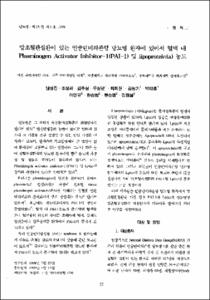KUMEL Repository
1. Journal Papers (연구논문)
1. School of Medicine (의과대학)
Dept. of Internal Medicine (내과학)
말초혈관질환이 있는 인슐린비의존형 당뇨병 환자에 있어서 혈액 내 Plasminogen Activator Inhibitor - 1 ( PAI - 1 ) 및 lipoprotein ( a ) 농도
- Keimyung Author(s)
- Lee, In Kyu; Han, Sung Beom; Han, Seung Yeup
- Department
- Dept. of Internal Medicine (내과학)
- Journal Title
- 당뇨병
- Issued Date
- 1999
- Volume
- 23
- Issue
- 1
- Abstract
- Objectives: The plasminogen activator inhibitor-1 (PAI-I) and lipoprotein(a) are considered as important fibrinolysis inhibitors. We evaluated PAI-1 and Lp(a) concentrations in Korean non-insulin- dependent diabetes mellitus (NIDDM) patients with or without peripheral vascular disorder. Methods: By using National Diabetes Data Group (NDDG) criteria as a diabetes mellitus diagnostic criteria, a total of 127 Korean NIDDM patients were seleeted. The ankle brachial index was measured by segrnental volume plethysmography to diagnose peripheral vascular disease. We also examined clinical and biochemical parameters in NIDDM patients. Results: The duration of diabetes, systolic and diastolic pressures was significantly higher in diabetic patients with peripheral vascular disease (Group 2) than in diabetic patients without peripheal vascular disease (Group 1). The 24 hour urine microalbumin and PAI-1 levels in Group 2 were also significantly higher and the HDL-cholesterol level was lower than in Group 1. There were significant correlations between the plasma level of PAI-1 and BMI (r=0.466, p=0,007) or C-peptide level(r=0.517, p=0.012). Multivariate logistic regression analysis showed that Lp(a) and PAI-1 are independent risk factors for peripheral vascular disease. Conclusion: In the light of these results, it seems reasonable to suggest that high levels of PAI-1 and Lp(a) in NlDDM patients may play a role in the pathogenesis of peripheral vascular disease.
연구배경: 인술린비의존형 당뇨병 환지세서 말초혈 관질환이 없는 군 (Group 1)과 있는 군 (Group 2) 사 이에 PAI-1 농도 및 Lp(a) 농도의 차이가 있는가를 알 아보고 이들이 말초혈관질환의 독립적인 유발안자가 되는지를 획씬하기 위해 이 연구를 시행하였다.
방법: 임상적■뜨로 NDDG 기준에 의하여 인슐린비 의존형 당뇨병으로 진단 받은 환자중에서 과거력,이 학적검사와 소견에서 저명한 뇌혈관 및 심혈관 질환이 있는 환지를 제외한 127명을 대상으로 하였다 Segmental volume plethysmography (Life Science낸1’ Greenwich, USA)를 이용古1여 말초혈관질환을 진단하 였고 이들의 혈액을 채취하여 임상화학검시를; 실시하 였다.
결과: 1. Group 1과 Group 2 사이에는 나이, 성별, 체질량지수에 치이가 없었으나 당뇨병의 유병기간은 Group 2서 Group 1보다 유의하게 길었으며 (p<0.05), 수축기, 이완기 혈압도 Group 2이 Group 1보다 유의 하게 높았다 (P<0.05).
2. 두 군 사이의 검X(소견은 당화혈색소 농도 공복 혈당,C-맵티시드 총 콜레스테롤,저비중지단백 콜레 스테톨,중성지방은 두 군 간에 차이를 볼 수 없었으나 24시간 미세단백뇨는 Group 2에서 Group 1보다 유의 하게 증가되어 있었으며 고비중지단백 콜레스테롤은 Group 2보다 Group 1이 유의하게 높았다. 그리고 혈 청 PAI-1 도 Group 2가 Group 1보다 유의하게 높았다 (P<0.05).
3. 전체 당뇨병 환자를 대상으로 PAI-1 농도와 관련 이 있는 임싱쌍상 및 검사 소견올 보면 PAI-1 농도와 체질량지수(r=0.466, p=0.007) 및 C-펩타이드 (r=0.517, p=0.이2)가 유의한 상관이 있었다.
4. 말초혈관질환의 위험인자 분석에서 다변수 로지 스틱 회귀분석을 실시한 결과 체질량지수,4
결른: 이상의 결과 인슐린비의존형 당뇨병 환지세 서 말초혈관질환의 발생에는 Lp(a) 및 PA1-1 의 증가 가 중요한 위험인자로 생각되며 향후 다른 인자와의
연관성 및 보다 많은 환자를 대상으로 한 전향적 연구 가 필요할 것으로 사료된다.
- Alternative Title
- Plasma Concentrations of Plasminogen Activator Inhibitor-1(PAI-1) and Lipoprotein(a) in Non-Insulin-Dependent Diabetes Mellitus with Peripheral Vascular Disease
- Publisher
- School of Medicine
- Citation
- 남성진 et al. (1999). 말초혈관질환이 있는 인슐린비의존형 당뇨병 환자에 있어서 혈액 내 Plasminogen Activator Inhibitor - 1 ( PAI - 1 ) 및 lipoprotein ( a ) 농도. 당뇨병, 23(1), 55–61.
- Type
- Article
- ISSN
- 1015-6461
- Appears in Collections:
- 1. School of Medicine (의과대학) > Dept. of Internal Medicine (내과학)
- 파일 목록
-
-
Download
 oak-bbb-00277.pdf
기타 데이터 / 396.28 kB / Adobe PDF
oak-bbb-00277.pdf
기타 데이터 / 396.28 kB / Adobe PDF
-
Items in Repository are protected by copyright, with all rights reserved, unless otherwise indicated.